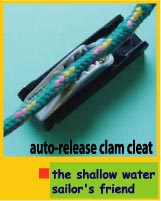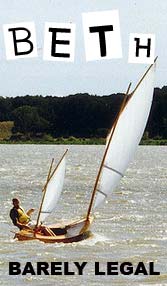
 Custom Search
|
| boat plans |
| canoe/kayak |
| electrical |
| epoxy/supplies |
| fasteners |
| gear |
| gift certificates |
| hardware |
| hatches/deckplates |
| media |
| paint/varnish |
| rope/line |
| rowing/sculling |
| sailmaking |
| sails |
| tools |
| join |
| home |
| indexes |
| classifieds |
| calendar |
| archives |
| about |
| links |
| Join Duckworks Get free newsletter CLICK HERE |
|
|
| Jagular Sets Sail - Part Two |
by Tom Pamperin
- Chippewa Falls, Wisconsin - USA |
Part One - Part Two Bear Lake is a long weed-fringed pond with a wide spot in the middle where powerboaters circle around a couple of buoys, pulling little kids on inner tubes. The kids all look like they’d rather be somewhere else. Now and then one of them falls off and starts to cry. The obnoxious two-stroke buzz of outboard motors fills the air, along with the smell of gasoline. The sun beats down on everything. There’s a boat ramp somewhere but not at this side of the lake where the campground is, so my brother and I back our trailers through the pines as close to the water’s edge as we can. From there we carry our boats down to the beach one by one and lay them on the sand side by side, ready for launching. My brother has designed his own boat instead of building from plans, and I can’t help thinking that the result is better than it should have been. Like my boat, it’s a simple flat-bottomed skiff. But where Jagular has a boxy slab-sided hull, my brother chose to fit three overlapping plywood planks on each side, a method that seems elegant and old-fashioned in comparison. Then instead of painting, he oiled and varnished the bare wood. Whenever people see his boat they say things like “Is that an antique?” and “Did you build that yourself?” When they see Jagular they hurry past without saying anything. “Somehow I thought there’d be a little more excitement,” I tell him. “Just wait,” Jagular says. Standing in the shallows beside him, I take the halyard in hand to hoist the sail for the first time. It’s a lot bigger in person than it was in the plans, this lateen rig -- an eighty-five-square-foot triangle to pull up the mast. The halyard attaches to an eighteen-foot-long club of solid Douglas-fir (the yard) that runs along the top edge of the sail. It’s heavy and cumbersome and seems ridiculously oversized. The yard is longer than the entire boat, in fact, which makes it incredibly awkward to handle. It overhangs the boat on both ends getting in the way of everything else while the sail billows around filling up the cockpit and spilling out into the water. “Here goes,” I say, and start to pull on the halyard. The yard slides reluctantly up the mast, unbalanced and spinning around uncontrollably, swinging at my shoulders and head. The sail tries to wrap itself around everything as it rises with the yard. The boat rocks back and forth violently under the yard’s shifting weight. “See what I mean?” Jagular says. “Shut up,” I tell him, and duck another jab from the yard. One hand for the halyard and one for the yard, that’s what it takes. And one hand to guard your head. And various other appendages. But finally I get the sail up and the halyard cleated off, leaving the whole rig hanging free above the cockpit. We’re ready to set sail. Stepping carefully into the middle of the cockpit, I sit down with my back against the side deck, tiller in hand. “We’re off,” I say. But the boat doesn’t move. The leeboards are aground, I realize, digging deeply into the sandy bottom and holding us stuck fast to the beach. I raise the boards and tie them off to their cleats. “Ok,” I tell the boat. “Now we’re off. Get going.” There’s not much wind, though, and it’s almost too hot to be out here without it. Even the powerboaters have given up; everything has wound down, all momentum drained from the day. But we slowly move away from the beach nevertheless, out toward deeper water. Motion without energy, acceleration without effort. It’s incredibly satisfying, if not terribly exciting. Even in this dead calm there’s enough wind to keep the sails filled. We’re sailing. # “You know, I could swim faster than this,” I tell Jagular after a few minutes. “I thought you were a Pirate Racer.” “It’s not my fault,” the boat says. “You probably did something wrong when you were building me.” We drift along for a few minutes more without saying anything else, and after a while we’re closer to the opposite shore than to our launching point. Still not much wind. Overhead the big lateen sail waves slowly back and forth without enthusiasm. The water is flat and motionless. The occasional bass or bluegill flickers past beneath us looking for shade. A horsefly buzzes slowly around my head, too lazy to attack. Up ahead my brother’s boat has reached the far end of the lake and is heading back. “Day after day, day after day, we stuck, nor breath nor motion,” I say, trailing my fingers in the water and flicking them at the horsefly, which lands on the side deck and eyes me suspiciously. We slide a few yards farther across the lake. Still too hot. Now and then the shadow of the sail falls across the cockpit and brings a moment of shade. Exciting stuff, this sailing. The horsefly eventually abandons ship and takes off on a sluggish flight across the lake, back toward the distant campground. Meanwhile we’re ghosting along toward the opposite shore. Nothing ahead of us but swampy low land and, a few yards back, an overgrown deerfly-and-bramble-thick woods. We drift for a few more minutes, getting slowly closer to the swamp and the waiting woods. Emphasis on the slowly. There’s plenty of time to practice: I experiment with the leeboards, raising and lowering them, tying and untying lines, making changes and adjustments as if I know what I’m doing. I experiment with the mainsheet, pulling the line in tighter, letting it run free, dropping it overboard, retrieving it. I shift my weight forward. I shift back. I move to the leeward side of the boat. I sit on the side deck. None of it makes any difference. We’re still drifting along at sub-glacial speeds, approaching the tall reeds and cattails at the lake’s edge. We’re about to be sliding right into the weeds, actually -- we’ve been moving so slowly that I haven’t been paying much attention. I push the tiller back and forth in a couple of last-minute attempts at evasive action, but we’re not moving fast enough for the rudder to make any difference. “Probably would’ve been a good idea to bring some oars along,” Jagular says. Then the bow pushes past the first row of cattails and we slide past into the swamp. Everything is quiet except for the sound of marsh grass and cattails scraping the hull as we move ahead until all but a thin swath of the lake is out of sight behind us. We’re following a narrow channel lined with cattails, a slim reedy passage barely wider than Jagular’s hull. A tunnel, basically. A one-way dead-end passage. “Yep,” the boat says. “Oars. For rowing and stuff, don’t you think?” Here in the weeds the air is thick and still. With a dull shluuuck we nose into the mud at the end of our dead-end channel. A few seconds later the horsefly reappears, buzzing in slow circles above my head, dropping lower and lower with each pass until it, too, finally comes to rest. It eyes me from the foredeck, safely out of reach. # “Just remember,” Jagular says as I’m tying everything onto the trailer for the drive home. “The longer boat is the faster boat.” “Oh, be quiet,” I tell him. “That’s one thing we can be sure of,” he says. “Especially since we’ve got an extra twenty-five square feet of sail.” I pretend not to hear him. After a moment he goes on. “I’ve never seen paint peel off in sheets like that before, though. Some of them looked big enough to use for a spare mainsail.” “So? The fiberglass on the bottom of your hull is completely waterproof anyway,” I tell him. “The paint was purely cosmetic.” “Most impressive, though,” he goes on as if I haven’t said anything -- “most impressive was the way you sailed us so far into those weeds that we had to have your brother come back and tow us out.” “I can’t help it if you refuse to sail backwards,” I say. I’m not really paying much attention, though. I’m too busy trying to figure out how to tie an eighteen-foot spar onto a fourteen-foot boat. I’ve run out of straps. All I have left is the mainsheet, which I wrap around and around everything I can reach until the entire cockpit is filled with a web of lines. Finally I decide it’s good enough, climb into the car, and drive off. Jagular bumps along on the trailer behind me, chuckling quietly. I glance in the rearview mirror as we reach the campground exit, and I can see long shreds of black paint hanging from the bottom of the hull. “Well,” I tell the boat. “Nobody’s perfect.” “That’s for sure,” he says. Just as we’re about to pull onto the highway, a horsefly buzzes in through the window and lands on the dash in front of me. He looks up at me briefly, glances back at Jagular, then shakes his head and flies away. |
 |


